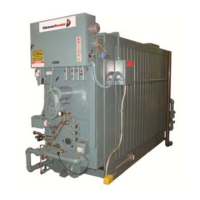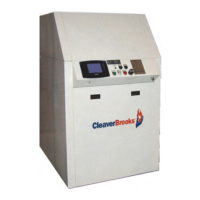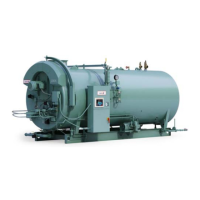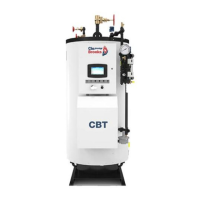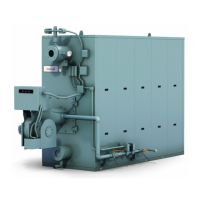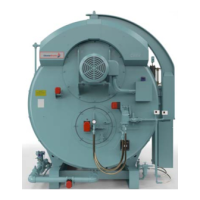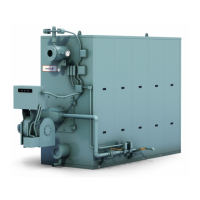750-211 (revised 2009)
Promethean Boilers, Model 4WI Manual
6-3
6.2 — Linkage: Modulating Motor and Air Damper
5. With the modulating motor in the low fire position, the arm on its shaft should be at an angle of 45º below the
horizontal. The driven arm on the jackshaft should also be 45º below horizontal. Secure both arms and fit the
connecting linkage rod in place between them.
6. Position the oil and/or gas modulating cams on the jackshaft so that the cam follower assembly is between the
first and second cam adjusting screws. In this position, fuel delivery is at low-fire rate. Tighten the setscrews to
secure the cams on the jackshaft.
7.The stop screw in the rotary air damper limits damper
travel at both closed (low-fire) and fully opened (high fire)
positions. The screw is provided so that it is possible to
tell, even with the burner in place, whether the damper
rotor is in fully opened or closed position. Rotating the
damper clockwise to the stopscrew closes the damper.
Rotating the damper counterclockwise to the stopscrew
opens the damper. Normally, the rate of flow of air
through the damper with the rotor in low-fire position is
about one-third of maximum for a standard burner or
one-sixth for a HTB.
FIGURE 6-2. Rotary Air Damper
8. The amount of angular movement controlling the rate of air flow is determined by the location of the ends of
the rotary air damper rod in both the jackshaft arm and the air damper arm. When the air damper is in low-fire
position, the jackshaft arm should be at 45º (47-1/2º for HTB) and the rotary air damper arm should be at an
angle of approximately 60º below the horizontal. This will ensure that the angular movement of the damper
starts slowly, increasing in rate as the high-fire position is approached.
9. Prior to initially firing a boiler, it is advisable to check for free movement of the linkage. The damper motor
must be allowed to complete its full stroke and the damper must move freely from low- to high-fire position.
Adjustment of linkage connected to a gas butterfly valve is described in Section 6.17.
Do not restrict the full travel of the modulating motor. Failure to follow these instructions could result in equipment
damage.
!
Caution
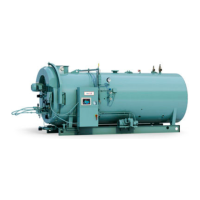
